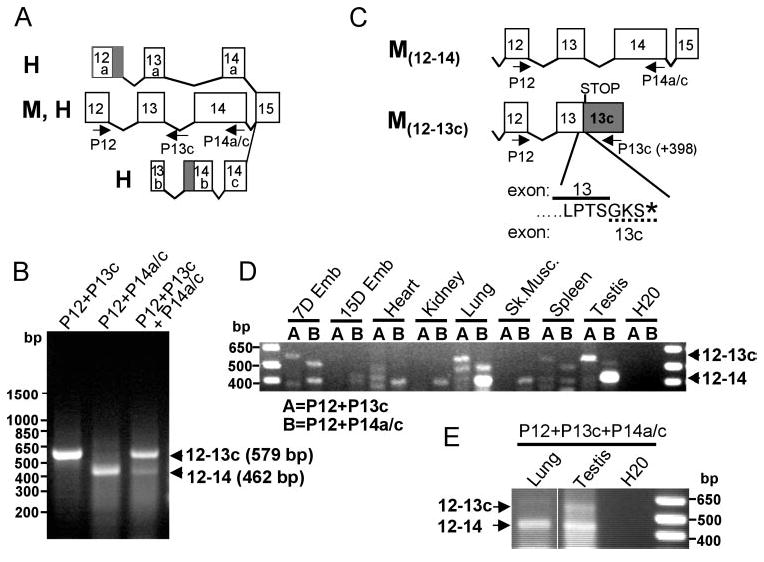Figure 1.

Identification of a novel and abundant rpgrip1 splice variant in the murine retina. (A) Schematic diagram of mRNA splice variants encompassing exons 12 and 14 of rpgrip1 identified to date in the human (H) and the murine (M) retinas. Only a single murine rpgrip1 isoform has been identified and molecularly defined. Primers used in this study are shown as arrows below the exons. Primers P12, P14a/c, and P13c are complementary to exons 12, 14a/c, and intron 13 (398 nucleotides downstream of the exon13–intron 13 boundary). (B) RT-PCR of retinal RNA by singleplex (lanes 1 and 2) and multiplex PCR (lane 3) with primers complementary to exon 12 (P12), exon 14 (P14a/c), and/or intron 13 (P13c). The combination of P12 with P13c and P12 with P14a/c amplified amplicons of 579 and 462 bp, respectively. The former was much more abundant than the latter in the retina. (C) Sequence analysis of the amplicons indicated the 462-bp product comprised the constitutive exons 12, 13, and 14 (M12–14), whereas the 579-bp product encompassed exons 12 and an extended exon 13 (exon 13c), which contained the constitutive exon 13 and 398 bp of intron 13 (M12–13c). This splice variant of rpgrip1 produced from the transcription of intron 13 leads to the premature termination of rpgrip1 and contains three unique residues (GKS) encoded by the extended exon 13c (dashed line). (D) Amplification of rpgrip1 isoforms comprising exons 12–14 and 12–13c from a normalized mouse tissue cDNA panel. In contrast to the retina, the truncated rpgrip1b isoform was detected in low abundance only in 7-day-old embryos, the testis, and the lung among all tissues tested. Conversely, the transcript containing exons 12–14 was very abundant in the lung and testis. (E) Multiplex PCR of normalized lung and testis cDNA confirmed the results obtained with the singleplex reactions in (D). Shaded blocks in (A) and (C) represent alternative extended exons previously reported.11,28
